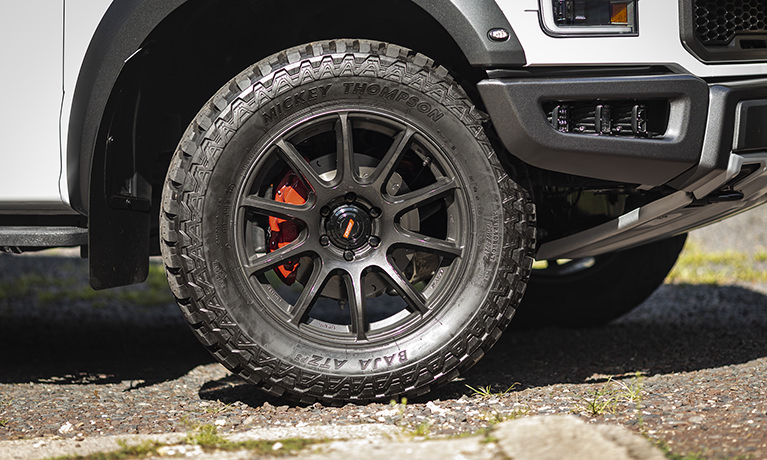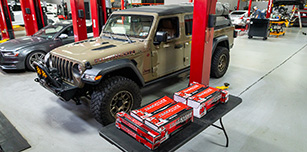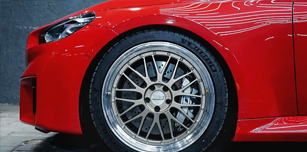It is no secret that big brake kits offer many advantages to the enthusiast: improved stopping power, longer pad life, and in many cases, vastly improved appearance, among other benefits. We recently had the opportunity to follow along as one of our Turn 14 Distribution teammates, Jeremy Sassaman, enlisted another colleague, Andrew Trujillo, to install a big brake kit from Alcon Components onto the front of his 2019 Ford F-150 SVT Raptor.

The kit consists of just a few pieces: new ductile iron caliper housings, fresh rotors, mounting brackets, pads, and ancillary hardware, and a new tie rod adapter kit from Addictive Desert Designs. Since the install is fairly simple, we invite you to follow along with the photos to see the process, and we’ll point out notable points of interest with respect to the install a bit further into the article.


But first, I chatted with Alcon’s Quinton Brantley about the kit’s development and design and learned a couple of things about Alcon as a company that surprised me. Specifically, Alcon Components has several military contracts, which help to drive the development process for the company’s products forward.
“This kit is derived from our military and armored business. What happens in the armored vehicle market is that when these guys do fitments on a vehicle to turn it into an armored vehicle, it has to look like the vehicle for the intended market. In this particular case, they would do the armored fitment and keep everything appearing as bone stock as possible, including the wheel size,” Brantley explains.





As we can see from the photos above, the stock brakes are adequate, but certainly not overkill. The Alcon Components big brake kit is used in those armored applications, so it must be incredibly robust and able to meet Mil-spec standards for performance and construction. To that end, the company selected a ductile iron, six-piston configuration for these Raptor calipers rather than manufacturing them from billet aluminum. The stiffness and rigidity give the caliper its immense strength, which is helpful when trying to harness the Raptor’s 5,700-pound curb weight and bring it to a stop.
One thing to note: Jeremy installed only the Alcon front big brake kit onto his truck, as Alcon’s rear fitment does not work on F-150s that utilize the electronic parking brake, like the brakes on the rear of his Raptor.

Alcon claims solid performance gains when comparing this system to the stock Raptor brake system: a 10-percent reduction in disc temperature rise, a 33-percent reduction in pad work rate, and even a reduction in pedal effort.
“It’s a really solid foundation that can withstand the elements and fit into a stock fitment wheel,” says Brantley.
The front calipers use a six-piston arrangement, with pistons sized to work properly with the stock master cylinder. Brantley says this is a critical feature: it’s designed to the vehicle for the vehicle and makes this a true plug-and-play installation. Each caliper wears epoxy acrylic paint over an acid zinc finish, designed to offer ultimate corrosion protection.
“Each piston has two seals; one is a pressure seal, and one is a wiper seal, which cleans the elements that the pistons are exposed to under normal operating conditions as they retract into the caliper. We’ve found that the wiper seals gives it much better performance, especially over the long term,” says Brantley.
Over the years we’ve seen many different rotor face treatments, from drilled holes to slots, to drilled-and-slotted, and even dimpled, but unboxing these Alcon rotors with their crescent grooves provided us with a new perspective.


“The advantage to these is that they give good cleanout, and also mitigate noise, which can be a concern. If you take the pad and lay it over the crescents, the crescents are always in contact with the pad. What that does is remove the drone under heavy braking and promotes even wear characteristics on the pad surface. It also doesn’t lend itself to stress risers, where straight slots open up the opportunity for a crack. The curve doesn’t accommodate that at all,” explains Brantley.
“This whole package has mass considerations: for durability, for consistent wear on all of the wearing components, and thermal mass in the rotor. That does give you better braking characteristics and wear characteristics; it runs cooler, so the pads wear less,” he says.


Since Andrew was about 95-percent sure we were going to need the tie rod adapter kit, he used a set of toe plates to check the alignment specifications on the truck. This baseline gave him a solid measurement to shoot for when the project wrapped up—if we needed the adapter kit.


Checking the new rotor installed with the stock tie rod ends in place shows how little clearance there really is, due to the added mass of the rotor. It was just a little bit too close for comfort, so we proceeded with the installation of the adapter kit.


These solid steel brackets work with the iron calipers to provide a serious amount of heft; one thing we missed was comparing the weight of the two components on the scale, but the hand scale says these new Alcon calipers and rotors are no joke.
The new calipers are a fixed design with retention bolts that go through the top of the caliper into the steel bracket, compared to the OEM units, which use slider pins through a cast bracket and mount to the spindle through the caliper ears.



The OEM brake hoses feature a retention pin that hooks into the hole on the back of the caliper; I suspect this is simply for ease of assembly on the manufacturing line, as it doesn’t seem to serve much of a purpose. Some quick work with the hacksaw and the pin was gone.





Jeremy headed off to Home Depot to pick up the necessary 5/8-inch drill bit to open up the spindle for the new spindle posts. After Andrew drilled the holes, he reamed out each one to ensure there were no burrs left over from the drilling process. With all of the pieces assembled and torqued, it’s clear that there is now plenty of room between the rotor and tie rod end.




One specific item we wanted to check was whether the new brake kit would fit behind the stock wheels. Jeremy’s truck is equipped with 20-inch Gram Lights 57 Trans-X wheels that offer plenty of clearance. With a set of 7 mm spacers installed, the stock 17-inch cast wheels have far less clearance between the caliper face and backside of the wheel, along with the barrel of the wheel to the top of the caliper when wheel weights are considered, but they do physically fit. Maybe with low-profile wheel weights, I’d feel more comfortable about the situation.
The moral of the story is to check, check, and check again before driving the vehicle. We did not install the spacers behind the Gram Lights as part of the final installation—they were on-hand to check fitment with the stock wheels.

Jeremy shared his driving impression of the system with us, and it is about what I expected to hear, given the appearance of the components.
“Immediately noticeable was the stiffer and higher pedal—the difference is notable. With the stock brakes, you would need to get about a third of the way into the pedal before you would even begin to get any grip on the rotor, and needed to go even a bit further to get a significant bite. Not to mention, the pedal feel was very soft throughout the engagement. With the Alcon kit, you get a stiff pedal virtually immediately and a very strong bite with minimal effort. Since the Raptor has so much suspension travel, you can feel the truck squatting considerably more under aggressive braking situations. Something else that is noteworthy: with the engine Stop/Start feature on in the truck, you barely need to touch the brake pedal with the Alcon set up to engage the feature. With the Stock brakes, your foot needs to be into the pedal a bit to trigger the engine stop. Aside from the performance improvements, they also look great and fill up the larger wheels nicely,” he says.

“The kit has been tested under all of the conditions that it can be tested against for the Mil-spec certification. It’s designed to run in all of the different environments that we can expose it to on the highway and off-highway. Everything’s so robust that it lends itself to a great solution,” sums up Brantley.



















